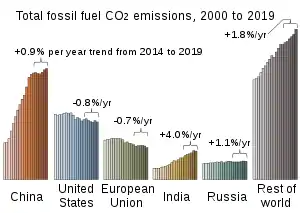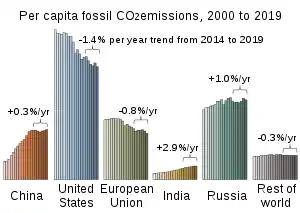Greenhouse gas emissions by Russia
Greenhouse gas emissions by Russia are the 4th largest in the world and derive mostly from fossil fuels. Russia emits about 1600 megatonnes (Mt) CO2eq of greenhouse gases each year;[1] about 5% of world emissions[2] and about 11 tons per person. Cutting greenhouse gas emissions, and therefore air pollution in Russia, would have health benefits greater than the cost.[3]

Greenhouse gas sources

2 emissions in China and the rest of world have eclipsed the output of the United States and Europe.[4]

2155 Mt of CO
2 was emitted in 2017 but 578 Mt was reabsorbed by land use, land-use change, and forestry (LULUCF).[1]
Russia must submit its inventory of 2018 emissions to the UNFCCC by 15 April 2020, and so on for each calendar year.[5]
In 2017, Russia emitted 11.32 tons of CO2 per person.[6]
Energy
In 2017 Russia's energy sector, which under IPCC guidelines includes fuel for transport, emitted almost 80% of the country's greenhouse gases.[1] Industrial Processes and Product Use (IPPU) emitted over 10%. The largest emitters are energy industries—mainly electricity generation—followed by fugitive emissions from fuels, and then transport.[1]
Energy from fossil fuels
Most emissions are from the energy sector burning fossil fuels.
According to the Russian Science Foundation in 2019, the natural influx of greenhouse gases from terrestrial ecosystems in Russia constantly changes. Measuring these influxes had shown that greenhouses gases into the atmosphere in short time intervals is contributing to the deceleration of warming in Russia. This is attributed to the fact that the effect of temperature growth deceleration, due to absorption of CO2 by the terrestrial ecosystems from the atmosphere, is stronger than the effect of warming acceleration caused by the emission of CH4 into the atmosphere.
The effect of terrestrial ecosystems contributing to the deceleration of global warming in the Russian regions grows in the first half of the 21st century and decreases by the end of the century upon reaching the maximum, depending on the scenario of anthropogenic emissions, under all studied scenarios of anthropogenic impacts resulting from the growth in natural emissions of CH4 and the decrease in CO2 absorption by the terrestrial ecosystems. In accordance with the results obtained, under the scenarios of anthropogenic emissions considered, the natural emissions from the Russian regions will also accelerate climate warming on the short time horizons under the climate conditions of the second half of the 21st century.
Gas fired power stations
Gas fired power stations are a major source.[7]
Agriculture
In 2017, agriculture emitted 6% of Russia's greenhouse gases.[1]
Waste
In 2017, waste emitted 4% of the country's greenhouse gases.[1]
Land
Russian challenges for forests include control of illegal logging,[8] corruption, forest fires and land use.
As well as trees burning peat burning in wildfires emits carbon.[9]
Planning and forecasts
International comparison of mitigation targets
Climate action tracker found Russian to be "critical insufficient" .[10]
Reducing greenhouse gas emissions and increasing absorption (climate change mitigation)
Energy
In 2020, Russia released a draft long-term strategy, to reduce CO2 emissions by 33% by 2030 compared to 1990. It did not plan to reach net-zero until as late as 2100.[11]
Economics
As Russia has no carbon tax or emissions trading[12] it could be vulnerable to future carbon tariffs imposed by the EU,[13][14] or other export partners.[15]
Carbon sinks
Carbon sinks, which in Russia consist mainly of forests, offset about a quarter of national emissions in 2017.[1]
Economics
Politics
Russia is party to international agreements on climate change. In September 2019, Russia announced that it will implement the 2015 Paris Agreement to fight climate change.[16] Russia ratified the Kyoto protocol in November 2009.[17] It came in force on 16 February 2010. This agreement did not cause emission cuts for Russia due to an earlier drop in emissions compared to year 1990 for other reasons, mainly a significant drop in economic growth. Six G8 countries would have been ready for the agreement to "at least halve global CO
2 emissions by 2050" in 2007. Russia and the United States did not agree.[18]
Access to data
Data is scarce and out of date.[19]
See also
Notes
References
- "Summary of GHG Emissions for Russian Federation" (PDF). UNFCCC.
- "BROWN TO GREEN: THE G20 TRANSITION TO A LOW-CARBON ECONOMY | 2017" (PDF). Climate Transparency.
- Sampedro, Jon; Smith, Steven J.; Arto, Iñaki; González-Eguino, Mikel; Markandya, Anil; Mulvaney, Kathleen M.; Pizarro-Irizar, Cristina; Van Dingenen, Rita (2020-03-01). "Health co-benefits and mitigation costs as per the Paris Agreement under different technological pathways for energy supply". Environment International. 136: 105513. doi:10.1016/j.envint.2020.105513. ISSN 0160-4120.
- Friedlingstein et al. 2019, Table 7.
- "Reporting requirements | UNFCCC". unfccc.int. Retrieved 2019-10-08.
- Ritchie, Hannah; Roser, Max (2020-06-11). "CO₂ and Greenhouse Gas Emissions". Our World in Data.
- IntelliNews, Ben Aris for bne (2019-09-30). "The Cost of Carbon in Russia". The Moscow Times. Retrieved 2019-10-29.
- "Russia's forests threatened by illegal logging | DW | 25.03.2019". DW.COM. Retrieved 2019-10-29.
- Page, Michael Le. "Russia has declared a state of emergency over Siberian wildfires". New Scientist. Retrieved 2019-10-29.
- "Russian Federation | Climate Action Tracker". climateactiontracker.org. Retrieved 2020-11-29.
- "Russia's Proposed Climate Plan Means Higher Emissions Through 2050". World Resources Institute. 2020-04-13. Retrieved 2020-11-29.
- "Taxing Energy Use 2019: Country Note – Russia" (PDF). OECD.
- "Carbon tariffs are EU's secret weapon in trade battle". Daily Telegraph. 5 June 2018. Archived from the original on 6 May 2019. Retrieved 24 February 2019.
- "Pollution Costs at Decade High Squeeze Industry, Coal in Europe". Bloomberg. 24 August 2018. Archived from the original on 11 June 2019. Retrieved 24 February 2019.
- "Carbon Tariffs: A Climate Necessity?". Kluwer Regulating for Globalization. Archived from the original on 11 October 2018. Retrieved 11 October 2018.
- "Russia gives definitive approval to Paris climate accord". Reuters. 2019-09-23. Retrieved 2019-09-25.
- "ENTRY INTO FORCE OF KYOTO PROTOCOL, FOLLOWING RUSSIA'S RATIFICATION, HISTORIC STEP FORWARD TO COMBAT GLOBAL WARMING, SECRETARY-GENERAL SAYS IN NAIROBI | Meetings Coverage and Press Releases". www.un.org. Retrieved 2020-01-31.
- UNEP Year Book2008, An Overview of Our Changing Environment Archived 1 April 2016 at the Wayback Machine, United Nations Environment Programme 2008 pages 2
- Israel, Ron (2019-06-06). "Current Russian Data on Greenhouse Gas Emissions is Scarce and Significantly Out-of-Date". Climate Scorecard. Retrieved 2019-10-29.
Sources
- "2020 National Inventory Report".
- "Russian Greenhouse Gas Inventory 1990 - 2018 common reporting format (CRF) tables" (RUS_2020_2018_13042020_230905.xlsx). April 2020.
External links
- Live carbon emissions from electricity generation in European Russia and Ural
- Live carbon emissions from electricity generation in Siberia
- Greenhouse Gas Inventory to 2017 in downloadable spreadsheets
- National Greenhouse Gas Inventory to 2017 Report
- Status report on the annual inventory of Russia for 2016
- Greenhouse Gas Inventory Data - Flexible Queries Annex I Parties
- NDC Registry (only a flag so far)
- Climate Action Tracker: Russia
- Climate Watch: Russia